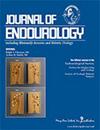无监督机器学习识别输尿管盆腔交界处梗阻肾盂成形术失败的风险因素
IF 2.9
2区 医学
Q1 UROLOGY & NEPHROLOGY
引用次数: 0
摘要
导言:对于输尿管肾盂连接部梗阻(UPJO)的成年患者,预测肾盂成形术结果的数据很少,而且肾盂成形术成功与否也没有统一的定义。因此,回顾性地定义肾盂成形术的成功与否特别容易产生偏差,使研究人员能够在事后选择重要的结果。为了减少这些偏差,我们对来自一家多医院系统的 2015 年至 2023 年间 216 例肾盂成形术患者的数据集进行了无监督机器学习聚类分析,以确定结果较差的患者的决定性风险因素。方法利用术前和围手术期数据拟合 KPrototypes 模型,并对术后结果进行盲法分析。通过 T 检验和卡方检验来观察组群间特征的显著差异。通过随机森林分类器计算出 SHapley Additive exPlanation 值,以确定对群组成员身份最具预测性的特征。逻辑回归模型确定了哪些最具预测性的变量在调整混杂效应后仍具有显著性。结果:确定了两个不同的群组。其中一个群组(被称为 "高风险 "群组)包含 111 名(51.4%)患者,其合并症较多,如高龄(62.7 vs 35.7)、高体重指数(BMI)(26.9 vs 23.8)、高血压(66.7% vs 17.1%)和曾接受过腹部手术(72.1% vs 37.1%),且结果较差,如严重术后并发症较多(7.2% vs 1.0%)。在调整了混杂效应后,高风险群组成员的最大预测特征是年龄大、术前估计肾小球滤过率(eGFR)低、高血压、体重指数(BMI)较大、曾接受腹部手术和左侧UPJO。结论:年龄较大、eGFR 较低、高血压、体重指数(BMI)较高、曾接受过腹部手术和左侧 UPJO 的成人 UPJO 患者自然会聚集成一个群体,而这个群体更容易出现围手术期并发症和更差的预后。对于具有这些风险因素的患者,术前咨询和围手术期管理可能需要采取不同的思路或方法。本文章由计算机程序翻译,如有差异,请以英文原文为准。
Unsupervised Machine Learning to Identify Risk Factors of Pyeloplasty Failure in Ureteropelvic Junction Obstruction.
Introduction: In adult patients with ureteropelvic junction obstruction (UPJO), little data exist on predicting pyeloplasty outcome, and there is no unified definition of pyeloplasty success. As such, defining pyeloplasty success retrospectively is particularly vulnerable to bias, allowing researchers to choose significant outcomes with the benefit of hindsight. To mitigate these biases, we performed an unsupervised machine learning cluster analysis on a dataset of 216 pyeloplasty patients between 2015 and 2023 from a multihospital system to identify the defining risk factors of patients that experience worse outcomes. Methods: A KPrototypes model was fitted with pre- and perioperative data and blinded to postoperative outcomes. T-test and chi-square tests were performed to look at significant differences of characteristics between clusters. SHapley Additive exPlanation values were calculated from a random forest classifier to determine the most predictive features of cluster membership. A logistic regression model identified which of the most predictive variables remained significant after adjusting for confounding effects. Results: Two distinct clusters were identified. One cluster (denoted as "high-risk") contained 111 (51.4%) patients and was identified by having more comorbidities, such as old age (62.7 vs 35.7), high body mass index (BMI) (26.9 vs 23.8), hypertension (66.7% vs 17.1%), and previous abdominal surgery (72.1% vs 37.1%) and was found to have worse outcomes, such as more frequent severe postoperative complications (7.2% vs 1.0%). After adjusting for confounding effects, the most predictive features of high-risk cluster membership were old age, low preoperative estimated glomerular filtration rate (eGFR), hypertension, greater BMI, previous abdominal surgery, and left-sided UPJO. Conclusions: Adult UPJO patients with older age, lower eGFR, hypertension, greater BMI, previous abdominal surgery, and left-sided UPJO naturally cluster into to a group that more commonly suffers from perioperative complications and worse outcomes. Preoperative counseling and perioperative management for patients with these risk factors may need to be thought of or approached differently.
求助全文
通过发布文献求助,成功后即可免费获取论文全文。
去求助
来源期刊

Journal of endourology
医学-泌尿学与肾脏学
CiteScore
5.50
自引率
14.80%
发文量
254
审稿时长
1 months
期刊介绍:
Journal of Endourology, JE Case Reports, and Videourology are the leading peer-reviewed journal, case reports publication, and innovative videojournal companion covering all aspects of minimally invasive urology research, applications, and clinical outcomes.
The leading journal of minimally invasive urology for over 30 years, Journal of Endourology is the essential publication for practicing surgeons who want to keep up with the latest surgical technologies in endoscopic, laparoscopic, robotic, and image-guided procedures as they apply to benign and malignant diseases of the genitourinary tract. This flagship journal includes the companion videojournal Videourology™ with every subscription. While Journal of Endourology remains focused on publishing rigorously peer reviewed articles, Videourology accepts original videos containing material that has not been reported elsewhere, except in the form of an abstract or a conference presentation.
Journal of Endourology coverage includes:
The latest laparoscopic, robotic, endoscopic, and image-guided techniques for treating both benign and malignant conditions
Pioneering research articles
Controversial cases in endourology
Techniques in endourology with accompanying videos
Reviews and epochs in endourology
Endourology survey section of endourology relevant manuscripts published in other journals.
 求助内容:
求助内容: 应助结果提醒方式:
应助结果提醒方式:


